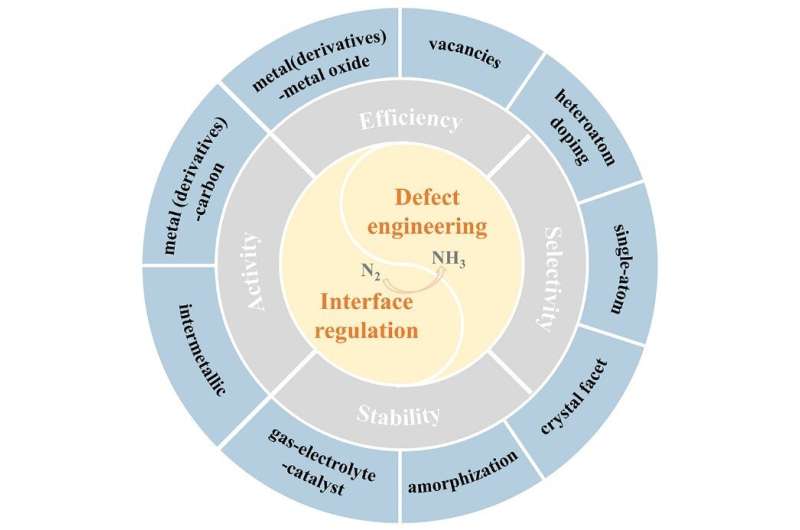
The electrochemical nitrogen reduction reaction (e-NRR) under ambient conditions is an emerging strategy used to tackle the hydrogen- and energy-intensive processes entailed in industrial ammonia (NH3) synthesis via the traditional Haber-Bosch process. However, e-NRR performance is currently impeded by the inherent inertness of N2 molecules, extremely slow kinetics, and overwhelming competition from the hydrogen evolution reaction (HER), all of which result in an unsatisfactory yield and ammonia selectivity.
To achieve a high-selectivity and high-performance NRR under ambient conditions, the rational design of efficient electrocatalysts is urgently required. Defect and interface engineering are capable of achieving novel physical and chemical properties, as well as superior synergistic effects for various electrocatalysts.
Recently, the Wang Danhong research group of Nankai University reviewed the latest progress of e-NRR catalysts under ambient conditions from the perspective of defect and interface engineering. The authors first provided a general introduction to the NRR mechanism. Subsequently, the authors provided a comprehensive and detailed review on defect and interface engineering for e-NRR electrocatalysts, emphasizing the elucidation of active sites and intrinsic mechanisms.
They discussed how the defect (vacancies, heteroatom doping, single-atom, crystal facets, amorphization) engineering and the surface (metal-metal oxide interface, metal-carbon material interface, intermetallic compounds from the viewpoint of alloyed structures, gas-electrolyte-catalyst interface) regulation alter the number of active sites or the electronic structure, and then promote the activity of NRR electrocatalysts.
In the final section, the authors summarized the present research status and challenges in this emerging field from different aspects and discussed the potential strategies to develop more advanced NRR electrocatalysts. It is expected that this review will be stimulating and assist researchers to create more efficient catalysts for the electrochemical NRR.
Explore further
Citation: Defect and interface engineering for e-NRR under ambient conditions (2021, June 28) retrieved 29 June 2021 from https://ift.tt/3hu42yD
This document is subject to copyright. Apart from any fair dealing for the purpose of private study or research, no part may be reproduced without the written permission. The content is provided for information purposes only.
"interface" - Google News
June 28, 2021 at 09:39PM
https://ift.tt/3hu42yD
Defect and interface engineering for e-NRR under ambient conditions - Phys.org
"interface" - Google News
https://ift.tt/2z6joXy
https://ift.tt/2KUD1V2
Bagikan Berita Ini














0 Response to "Defect and interface engineering for e-NRR under ambient conditions - Phys.org"
Post a Comment